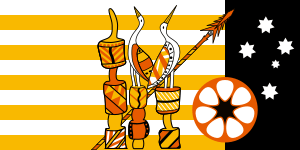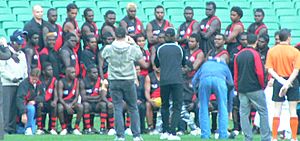Tiwi people facts for kids
 |
|

The Tiwi Bombers, a local football team from the Tiwi Islands
|
|
| Total population | |
|---|---|
| 2,000 | |
| Regions with significant populations | |
| Australia (Northern Territory) | |
| Languages | |
| Tiwi | |
| Related ethnic groups | |
| See List of Australian Aboriginal group names |
The Tiwi people are an Aboriginal group from Australia. About 2,000 Tiwi people live on Bathurst and Melville Islands. These islands are known as the Tiwi Islands. They are located about 30 miles (50 km) from Darwin.
The Tiwi language is unique. It does not seem to be related to other languages spoken on the Australian mainland. Tiwi society is based on matrilineal descent. This means family lines are traced through the mother. Marriage is also very important in their lives. Art and music are a big part of their culture and spiritual traditions. Over time, people from other Aboriginal groups also came to live on the Tiwi Islands.
Contents
What Language Do the Tiwi People Speak?
The Tiwi people speak the Tiwi language. It is a very complex language. It is different from all other Australian languages. It has no clear connection to the languages spoken on the nearby mainland. This makes it a "language isolate."
Where Do the Tiwi People Live and What is Their History?
The Tiwi people traditionally lived on Melville and Bathurst islands. These islands cover about 3,100 square miles (8,000 km²). The Tiwi Islands are about 50 miles (80 km) from Darwin. Melville and Bathurst are the two main islands where people live. They were originally called Ratuwati Yinjara, meaning "two islands." There are also many smaller islands that are not lived on. The Tiwi Islands are now part of the Northern Territory of Australia.
Dutch explorers first landed on Melville Island in 1705. However, they did not settle there. The British tried to settle in 1824 but failed. Europeans did not settle on the islands until German missionaries arrived in 1911.
How Do Tiwi Families Work?
The Tiwi people trace their family lines through their mothers. This is called a matrilineal descent group. The Tiwi call these groups "skin." They believe that spirits from bodies of water become unborn babies. A man's role is to find a spirit and send it to his wife. The spirit's "skin" group must match the wife's.
All Tiwi members are related to each other in some way. This is divided into "close" and "far away" kinship. "Close kin" are people like your mother, father, sister, or brother. These are people in your immediate family or band unit. Tiwi society is very welcoming. They often call newcomers "son" or "daughter." This is a "far away" kinship. Other races were sometimes seen as outsiders.
Why is Marriage Important to the Tiwi?
Marriage is very important for the Tiwi people. It affects their economic, social, and political standing. Almost everyone gets married, especially women. Since both men and women trace their family lines through their mothers, the wife's family group is very important.
It is common for Tiwi widows to remarry quickly. This often happens right after their husband dies. The new marriage takes place at the previous husband's grave. Older women often marry younger, less experienced men. This is because the most skilled hunters are usually already married.
Older, successful men often had many wives. Some had up to 20 wives. Men younger than 30 usually had fewer or no wives. In traditional Tiwi culture, men aged 30–40 were most likely to marry widows. Older women were very important in society. They knew how to gather food, which was essential for the household. Younger women learned gathering skills from older women.
Marriage customs have changed a lot since Catholic missionaries arrived after 1945. In traditional Tiwi culture, men had more political power. However, women were highly respected for their gathering skills. They provided food and other important things for their families.
What Do the Tiwi Hunt and Eat?
Hunting for food is still a big part of Tiwi life.
- On land, they hunt for wallabys, lizards, possums, carpet snakes, pigs, buffalo, flying foxes, bandicoots, and magpie geese. They also collect turtle and seagull eggs.
- From the sea, they hunt for turtles, crocodiles, dugongs, and fish.
What is Tiwi Dance Like?
Dancing, or yoi, is part of everyday life. Tiwi people inherit their special totemic dance from their father. These dances connect them to the Dreamtime and their spiritual identity. They also perform narrative dances. These dances tell stories about daily life or past events. The islands are heavily forested.
Art, Music, and Rituals of the Tiwi People
What is Tiwi Art?
Tiwi art often looks abstract and uses geometric shapes. It has strong patterns and bright colors. This makes Tiwi art very beautiful and popular. Tiwi art tells stories. The patterns often show friendships within the community. Many art experts have studied Tiwi art. They have learned the meaning of Tiwi symbols. Tiwi art helps pass down history and wisdom through generations.
English is taught in schools as a second language. However, the Tiwi people mainly speak their own language. When someone dies, the Tiwi paint their bodies. They express their love for the person through music, art, and dance. Painting has been a part of their ceremonies for thousands of years. Tiwi totem poles are famous and have been sold worldwide.
The Tiwi use natural ochre pigments for their art. They get these colors from the earth. When a person dies, their name becomes sacred. For many years, their name cannot be spoken as their spirit returns to the land. When the Tiwi find food in the bush, they never take mothers or baby animals. This shows their great respect for the land. It also shows their knowledge of how to protect the environment.
What is Tiwi Music Like?
Music is a very important part of life on the Tiwi Islands. It is central to ceremonies like the kulama (yam) initiation. The creative use of songs in these events is now at risk. This is because traditional rituals are becoming less common.
The Tiwi people sing songs about the land. These songs have been passed down for many generations. They sing about many parts of their lives. This includes hunting, cooking, family, animals, plants, and the Australian outback. Some of these songs have been recorded and saved. The Tiwi "strong women's group" is working to preserve their music. Research has helped bring back some old songs. These songs have been sung for thousands of years. So, this research is done with great care and respect.
The music of the Tiwi women's "strong women's group" is being preserved and revived. This work is happening on Bathurst and Melville islands.
Notable Tiwi People
Images for kids



